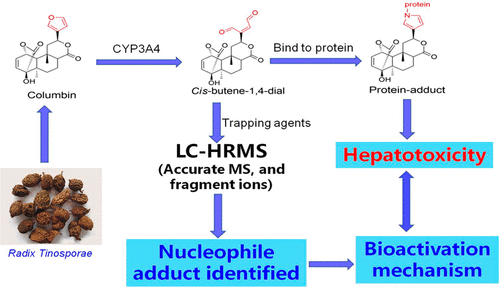当前位置:
X-MOL 学术
›
Chem. Res. Toxicol.
›
论文详情
Our official English website, www.x-mol.net, welcomes your
feedback! (Note: you will need to create a separate account there.)
Cytochrome P450 Enzyme-Mediated Bioactivation as an Underlying Mechanism of Columbin-Induced Hepatotoxicity.
Chemical Research in Toxicology ( IF 3.7 ) Pub Date : 2020-03-20 , DOI: 10.1021/acs.chemrestox.9b00486 Jiaping Pei 1, 2 , Wen Xiao 3 , Danyan Zhu 1 , Xiaowei Ji 1 , Liping Shi 1 , Xiaozhao Deng 1, 2
Chemical Research in Toxicology ( IF 3.7 ) Pub Date : 2020-03-20 , DOI: 10.1021/acs.chemrestox.9b00486 Jiaping Pei 1, 2 , Wen Xiao 3 , Danyan Zhu 1 , Xiaowei Ji 1 , Liping Shi 1 , Xiaozhao Deng 1, 2
Affiliation

|
Columbin, a furanoid compound, is the major bioactive ingredient of Tinospora sagittata (Oliv.) Gagnep, a traditional Chinese medicine that has been reported to cause liver injury in the clinic. The aim of this study was to investigate the hepatotoxicity caused by columbin and its underlying mechanism. Our results indicated that columbin could result in a dose-dependent increase of mice serum alanine aminotransferase and aspartate aminotransferase after oral treatment with columbin, as well as local spotty necrosis in the liver of mice treated with columbin. No hepatotoxicity was observed in mouse treated with the same dose of tetrahydrocolumbin. Pretreatment with ketoconazole preserved the mice from columbin-induced hepatotoxicity. Further studies suggested that bioactivation of the furan ring played an indispensable role in columbin-caused hepatotoxicity. In vitro and in vivo metabolism studies demonstrated that columbin could be metabolized into the cis-butene-1,4-dial intermediate, which readily reacted with glutathione and N-acetyllysine to form stable adducts. Ketoconazole displayed strong inhibitory effect on the generation of M4 and M5 both in vitro and in vivo. Further recombinant human CYP450 screening demonstrated that CYP3A4 was the major enzyme responsible for columbin bioactivation. The present study demonstrated that columbin was hepatotoxic and CYP3A4-mediated bioactivation of the furan ring would serve as an underlying mechanism for columbin-induced hepatotoxicity.
中文翻译:

细胞色素P450酶介导的生物激活作为哥伦宾诱导的肝毒性的潜在机制。
哥伦宾是一种呋喃类化合物,是一种传统的中药Tinospora sagittata(Oliv。Gagnep)的主要生物活性成分,据报道在临床上会引起肝损伤。这项研究的目的是调查由columbin引起的肝毒性及其潜在机制。我们的研究结果表明,在用Columbin口服治疗后,Columbin可能导致小鼠血清丙氨酸氨基转移酶和天冬氨酸氨基转移酶的剂量依赖性增加,以及用Columbin治疗的小鼠肝脏中局部斑点坏死。在用相同剂量的四氢钴蛋白治疗的小鼠中未观察到肝毒性。用酮康唑进行预处理可保护小鼠免于哥伦宾诱导的肝毒性。进一步的研究表明,呋喃环的生物活化在引起哥伦宾引起的肝毒性中起着不可或缺的作用。体外和体内代谢研究表明,columbin可以代谢为顺式丁烯-1,4-丁醛中间体,该中间体容易与谷胱甘肽和N-乙酰赖氨酸反应形成稳定的加合物。酮康唑在体外和体内均表现出对M4和M5生成的强烈抑制作用。进一步的重组人CYP450筛选显示CYP3A4是负责columbin生物激活的主要酶。本研究表明,columbin具有肝毒性,而CYP3A4介导的呋喃环生物活化作用可能是columbin诱导的肝毒性的潜在机制。体外和体内代谢研究表明,columbin可以代谢为顺式丁烯-1,4-丁醛中间体,该中间体容易与谷胱甘肽和N-乙酰赖氨酸反应形成稳定的加合物。酮康唑在体外和体内均表现出对M4和M5生成的强烈抑制作用。进一步的重组人CYP450筛选显示CYP3A4是负责columbin生物激活的主要酶。本研究表明,columbin具有肝毒性,而CYP3A4介导的呋喃环生物活化作用可能是columbin诱导的肝毒性的潜在机制。体外和体内代谢研究表明,columbin可以代谢为顺式丁烯-1,4-丁醛中间体,该中间体容易与谷胱甘肽和N-乙酰赖氨酸反应形成稳定的加合物。酮康唑在体外和体内均表现出对M4和M5生成的强烈抑制作用。进一步的重组人CYP450筛选显示CYP3A4是负责columbin生物激活的主要酶。本研究表明,columbin具有肝毒性,而CYP3A4介导的呋喃环生物活化作用可能是columbin诱导的肝毒性的潜在机制。酮康唑在体外和体内均表现出对M4和M5生成的强烈抑制作用。进一步的重组人CYP450筛选显示CYP3A4是负责columbin生物激活的主要酶。本研究表明,columbin具有肝毒性,而CYP3A4介导的呋喃环生物活化作用可能是columbin诱导的肝毒性的潜在机制。酮康唑在体外和体内均表现出对M4和M5生成的强烈抑制作用。进一步的重组人CYP450筛选显示CYP3A4是负责columbin生物激活的主要酶。本研究表明,columbin具有肝毒性,而CYP3A4介导的呋喃环生物活化作用可能是columbin诱导的肝毒性的潜在机制。
更新日期:2020-04-23
中文翻译:

细胞色素P450酶介导的生物激活作为哥伦宾诱导的肝毒性的潜在机制。
哥伦宾是一种呋喃类化合物,是一种传统的中药Tinospora sagittata(Oliv。Gagnep)的主要生物活性成分,据报道在临床上会引起肝损伤。这项研究的目的是调查由columbin引起的肝毒性及其潜在机制。我们的研究结果表明,在用Columbin口服治疗后,Columbin可能导致小鼠血清丙氨酸氨基转移酶和天冬氨酸氨基转移酶的剂量依赖性增加,以及用Columbin治疗的小鼠肝脏中局部斑点坏死。在用相同剂量的四氢钴蛋白治疗的小鼠中未观察到肝毒性。用酮康唑进行预处理可保护小鼠免于哥伦宾诱导的肝毒性。进一步的研究表明,呋喃环的生物活化在引起哥伦宾引起的肝毒性中起着不可或缺的作用。体外和体内代谢研究表明,columbin可以代谢为顺式丁烯-1,4-丁醛中间体,该中间体容易与谷胱甘肽和N-乙酰赖氨酸反应形成稳定的加合物。酮康唑在体外和体内均表现出对M4和M5生成的强烈抑制作用。进一步的重组人CYP450筛选显示CYP3A4是负责columbin生物激活的主要酶。本研究表明,columbin具有肝毒性,而CYP3A4介导的呋喃环生物活化作用可能是columbin诱导的肝毒性的潜在机制。体外和体内代谢研究表明,columbin可以代谢为顺式丁烯-1,4-丁醛中间体,该中间体容易与谷胱甘肽和N-乙酰赖氨酸反应形成稳定的加合物。酮康唑在体外和体内均表现出对M4和M5生成的强烈抑制作用。进一步的重组人CYP450筛选显示CYP3A4是负责columbin生物激活的主要酶。本研究表明,columbin具有肝毒性,而CYP3A4介导的呋喃环生物活化作用可能是columbin诱导的肝毒性的潜在机制。体外和体内代谢研究表明,columbin可以代谢为顺式丁烯-1,4-丁醛中间体,该中间体容易与谷胱甘肽和N-乙酰赖氨酸反应形成稳定的加合物。酮康唑在体外和体内均表现出对M4和M5生成的强烈抑制作用。进一步的重组人CYP450筛选显示CYP3A4是负责columbin生物激活的主要酶。本研究表明,columbin具有肝毒性,而CYP3A4介导的呋喃环生物活化作用可能是columbin诱导的肝毒性的潜在机制。酮康唑在体外和体内均表现出对M4和M5生成的强烈抑制作用。进一步的重组人CYP450筛选显示CYP3A4是负责columbin生物激活的主要酶。本研究表明,columbin具有肝毒性,而CYP3A4介导的呋喃环生物活化作用可能是columbin诱导的肝毒性的潜在机制。酮康唑在体外和体内均表现出对M4和M5生成的强烈抑制作用。进一步的重组人CYP450筛选显示CYP3A4是负责columbin生物激活的主要酶。本研究表明,columbin具有肝毒性,而CYP3A4介导的呋喃环生物活化作用可能是columbin诱导的肝毒性的潜在机制。











































 京公网安备 11010802027423号
京公网安备 11010802027423号